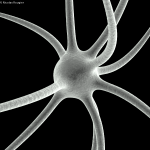The Firing of Developing Neurons
 At the University of Connecticut Health Center, researchers are now studying the development of neurons and their young firing patterns. It has been discovered that the neurons of fetuses as young as 20 to 21 weeks old fire in patterns that can be seen into adulthood. This is a glimpse into young nerve cells and can serve a basis to understanding what happens when brain development goes wrong.
At the University of Connecticut Health Center, researchers are now studying the development of neurons and their young firing patterns. It has been discovered that the neurons of fetuses as young as 20 to 21 weeks old fire in patterns that can be seen into adulthood. This is a glimpse into young nerve cells and can serve a basis to understanding what happens when brain development goes wrong.
The neurons fire pulses with periods of rest in between. This is commonly seen in sleeping adults. These pulses were seen between neurons located in the cerebral cortex. The cerebral cortex is involved in sensory information, thinking, emotion and consciousness. Even when they are not receiving input, the neurons will continue the pattern of firing and resting. When we sleep, our neurons will fire and rest as a way of reminding the rest of the brain that even though those cells are no longer working, they’re still alive! It’s as if the neurons are reminding the rest of the brain that they’re still there. Because this is seen in adults and in fetuses, this suggests that this alternative firing and resting activity is a very basic feature of the brain that starts occurring in very early developmental stages.
But now why are they firing so early in life? A mouse’s neurons will fire in synchronized waves. This plays a role in wiring the nervous system during development in order to link the neurons to corresponding body parts. Could this be the same for the human brain? Researchers are unsure if the developing neurons in lab dishes are in synch. If they are, the firing could be part of a mapping process during development.
Using this research, researchers might be able to soon look into what the result is when these neurons don’t form in the right places. The wrong positions might result in numerous disorders. Autism Spectrum disorders may also be related to improper firing.
| Print article | This entry was posted by Jennifer Aiello on February 18, 2011 at 3:27 pm, and is filed under G2C Online. Follow any responses to this post through RSS 2.0. You can skip to the end and leave a response. Pinging is currently not allowed. |







